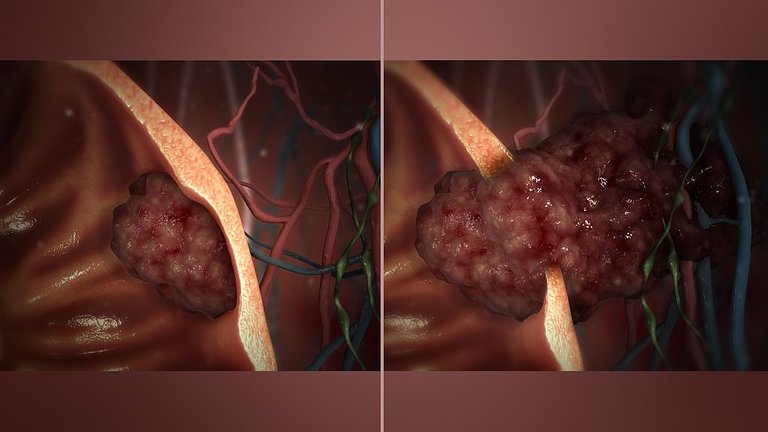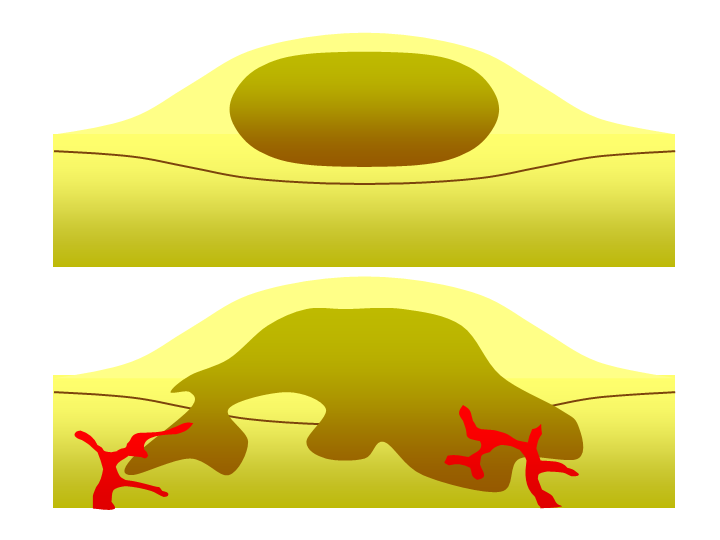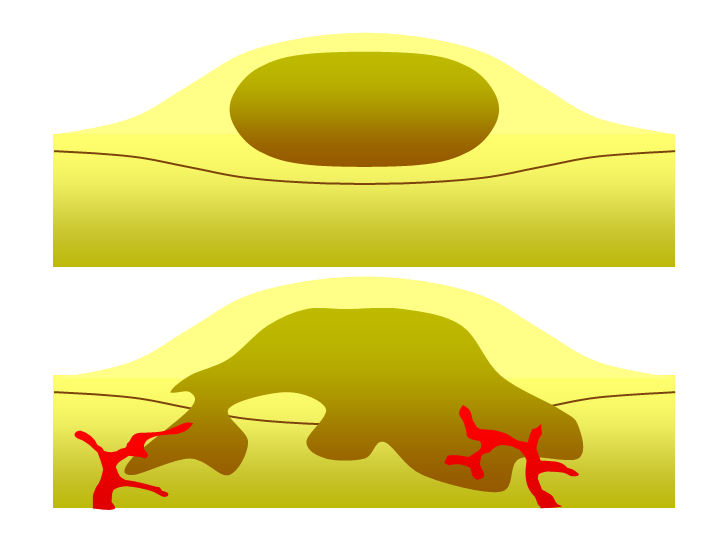Benign and Malignant tumor, characteristics / tumore benigno e maligno, caratteristiche
Introduction
in this short article the difference between a benign tumor and a malignant tumor or cancer will be quickly and effectively clarified
Benign and malignant tumors
In the first article of this series it was seen how the terms "cancer" and "oncology" derive from the Greek karkinos (= crab) and onkos (=mass) respectively and how the term "tumor" derives from the Latin tumor (= swelling). Another term used to refer to a tumor is "neoplasia".
Literally neoplasia means "new tissue" and perfectly indicates what a tumor is, i.e. a new tissue that was not there before and was not genetically programmed. Since it is not programmed, it has no function, it has a finalistic growth. It is a tissue for all intents and purposes because it is made up of parenchymal cells, which determine its type and function, and stroma, which includes all the non parenchymal cells of various types, such as the endothelial cells of the vessels, the smooth muscle cells of the arterioles, the lymphatic cells, the immune cells and many others. The function of a tissue is determined by the cells of the parenchyma, but without the stromal component they could not exist and survive.
A tumor is a tissue for all purposes precisely because it is composed of parenchymal cells, which are the cancer cells in the strict sense, i.e. the somatic cells genetically modified, and stromal cells, which are not genetically modified: without the stromal component the tumor could not exist and proliferate. In every tumor there may be a preponderance of parenchymal cells or stromal cells depending on the type.
The term neoplasia includes two very different types of tumors, although they have in common the fact that they are "new" tissues:
Benignus arises within a certain tissue through expansive growth, as if it were a balloon that swells, creating space in the surrounding tissue without damaging it. The growth rate can vary and if it is very slow it can also be surrounded by a fibrotic capsule and therefore limited. Since it does not damage healthy tissue, the benign tumor can be easily removed surgically without creating additional complications, if the fibrotic capsule is present the procedure is even simpler. After the removal of the benign tumor the patient is completely healed and the tissue does not suffer any consequences because it has not been damaged in any way by the tumor mass: the neoplastic history of the patient, therefore, ends with the removal of the tumor. Problems can occur if the benign neoplasm grows in anatomical areas that make removal difficult, such as in the cranial box, or in areas where the growing tumor compresses healthy cells by inducing death from apoptosis as in the case of benign brain tumors, or in areas where the tumor crushes a vessel causing hypoxia or ischemia of the tissues that are sprayed from the vessel, or in areas where the tumor crushes a tendon, nerve or vessel making removal more complicated, or if the tumor mass becomes hyper-secretory, as in benign tumors of the pituitary gland, for example. Benign tumors can evolve into malignancy and even there are those who argue that all benign tumors become malignant, but usually they are removed, or the subject dies of old age earlier, so this remains only a hypothesis.
Malignant (or cancer) does not grow expansively, but in an infiltrative way, i.e. the tumor cells in their growth creep into healthy tissue destroying and replacing it. A possible surgical removal, besides being more complicated, does not restore the tissue to a normal state, because it, which was previously healthy, has been damaged. For example, a progressing epithelial tumor reaches the basal membrane that delimits the epithelium, crossing it (unlike the benign one) and being able to invade organs near and far exploiting the circle and giving metastases, i.e. secondary tumors deriving from a tumor born in another organ. Therefore, an early diagnosis becomes fundamental, in order to decrease the amount of tissue that is destroyed by the infiltration of the neoplasm and the possibility that there has been metastasis.

However, there are other characteristics of benign and malignant tumors that can be taken into account, although they are not as discriminating, in fact they are not net limits, but rather nuances.
An example is the differentiating degree: a tumor arises from a cell of a tissue, which has definite primary characteristics, it then develops into a new tissue, giving rise to a neoplasm, which, as regards the parenchymatous component[ The tumor tissue parenchyma is made up of neoplastic cells, while the stroma has a supporting function, being made up of connective tissue and blood vessels, is represented by daughter cells, originating from a mother cell, which has the morpho-functional characteristics of the original tissue. This new tissue that is created can maintain more or less markedly the morpho-functional characteristics of the tissue from which it originates, thus maintaining or losing this degree of differentiation. Therefore, there are well differentiated tumors and tumors that are poorly differentiated or even anaplastic, i.e. completely undifferentiated. This degree of differentiation represents above all an anatomo-pathological discrimination, but sometimes it can also be from a functional point of view.
We can therefore define benign tumors as generally well differentiated, but this does not mean that there are also well differentiated malignant tumors. This is why the degree of differentiation of the tumour does not represent a net limit of discrimination between benign and malignant tumours; there may, in fact, be well differentiated malignant tumours or completely anaplastic malignant tumours.
At the tumor level, therefore, one can define the degree of differentiation of the tumor itself (grading), an analysis normally carried out by the pathologist observing the slides or preparations from the biopsy of the tumor itself, as this analysis participates in the diagnosis of the tumor and can also be a prognostic factor. Malignant tumors that are poorly differentiated tend to be more aggressive, i.e. they have a more inauspicious prognosis, compared to the same tumor with a higher degree of differentiation.
In conclusion: benign tumours differ from malignant tumours by growth modality (expansive vs. infiltrative). Secondly, it can be said that benign tumors tend to be well differentiated, while the degree of differentiation of malignant tumors is extremely variable. It can also be said that malignant tumors tend to grow faster than benign tumors. We use the term "tendentially" since, for example, malignant colon tumors are extremely slow in their growth, as is the progression of prostate cancer, but, at the same time, there are malignant tumors with very rapid growth, such as melanoma, which is extremely fast especially in its invasive capacity, or like lung cancer.
Ultimately, the only clear limit between benignity and malignancy is the mode of growth of the tumor. Another difference between the two types of tumor is the ability of the malignant tumor to metastasize, unlike benign tumors that do not tend to metastasize.

Introduzione
In questo breve articolo verrà chiarita in modo veloce ed efficace la differenza fra un tumore benigno e un tumore maligno o cancro
Tumori benigni e maligni
Nel primo articolo di questa serie è stato visto come il termine “cancro” e “oncologia” derivino rispettivamente dal greco karkinos (=granchio) e onkos (=massa) e come il termine “tumore” derivi dal latino tumor (=gonfiore). Un altro termine che viene utilizzato per indicare un tumore è “neoplasia”.
Letteralmente neoplasia significa “nuovo tessuto” ed indica perfettamente quello che è un tumore, ovvero un tessuto nuovo, che prima non c’era e non era programmato dal punto di vista genetico. Non essendo programmato non ha nessuna funzione, ha una crescita finalistica. É un tessuto a tutti gli effetti perché è formato da cellule parenchimali, che ne determinano tipologia e funzione, e stroma, che comprende tutte le cellule non parenchimali di vario tipo, come quelle endoteliali dei vasi, quelle muscolari lisce delle arteriole, quelle linfatiche, quelle immunitarie e molte altre. La funzionalità di un tessuto è determinata dalle cellule del parenchima, ma senza la componente stromale queste non potrebbero esistere e sopravvivere.
Un tumore è un tessuto a tutti gli effetti appunto perché è composto da cellule parenchimali, che sono le cellule tumorali in senso stretto, ovvero quelle somatiche geneticamente modificate, e da cellule stromali, che non sono geneticamente modificate: senza la componente stromale il tumore non potrebbe esistere e proliferare. In ogni tumore ci può essere una preponderanza di cellule parenchimali o di cellule stromali a seconda della tipologia.
Il termine neoplasia comprende due tipologie di tumori molto diversi tra di loro, nonostante questi abbiano in comune il fatto di essere dei tessuti “nuovi”:
Benigno sorge all’interno di un determinato tessuto mediante una crescita di tipo espansivo, come se fosse un palloncino che si gonfia, creandosi spazio nel tessuto circostante senza danneggiarlo. La velocità di crescita può variare e se è molto lenta può anche essere circondato da una capsula fibrotica e quindi limitato. Dato che non danneggia il tessuto sano, il tumore benigno può essere facilmente rimosso chirurgicamente senza creare ulteriori complicazioni, se è presente la capsula fibrotica la procedura è ancora più semplice. A seguito della rimozione del tumore benigno il paziente è completamente guarito e il tessuto non subisce nessuna conseguenza perché non è stato in alcun modo danneggiato dalla massa tumorale: la storia neoplastica del paziente, quindi, termina con la rimozione della neoplasia. Problematiche ci possono essere se la neoplasia benigna cresce in aree anatomiche che rendono difficile la rimozione, come nella scatola cranica, o in aree in cui il tumore crescendo comprime le cellule sane inducendone la morte per apoptosi come nel caso di tumori benigni al cervello, o in aree in cui il tumore schiaccia un vaso determinando ipossia o ischemia dei tessuti che vengono irrorati dal vaso, o in aree in cui il tumore schiaccia un tendine, un nervo o un vaso rendendo la rimozione più complicata, o se la massa tumorale diventa iper-secernente, come nei tumori benigni della ghiandola ipofisaria, per esempio. I tumori benigni possono evolvere verso la malignità e addirittura c’è chi sostiene che tutti i tumori benigni diventino maligni, ma solitamente vengono asportati, oppure il soggetto muore di vecchiaia prima, quindi questa rimane solo un’ipotesi.
Maligno (o cancro) non cresce in modo espansivo, ma in modo infiltrativo, ovvero le cellule tumorali nella loro crescita si insinuano nel tessuto sano distruggendolo e sostituendolo. Un eventuale rimozione chirurgica, oltre ad essere più complicata, non riporta il tessuto ad uno stato normale, perché esso, che precedentemente era sano, è stato danneggiato. Per esempio, un tumore epiteliale progredendo arriva alla membrana basale che delimita l’epitelio, attraversandola (a differenza del benigno) e potendo arrivare ad invadere organi vicini e lontani sfruttando il circolo e dando metastasi, ovvero tumori secondari derivanti da un tumore nato in un altro organo. Diventa fondamentale quindi una diagnosi precoce, per diminuire la quantità di tessuto che viene distrutto dall’infiltrazione della neoplasia e la possibilità che vi sia stata metastasi.

Tuttavia vi sono altre caratteristiche dei tumori benigni e maligni che possono essere prese in considerazione, sebbene non siano altrettanto discriminanti, infatti non rappresentano limiti netti, ma sono piuttosto delle sfumature.
Un esempio è il grado differenziativo: un tumore nasce da una cellula di un tessuto, che possiede caratteristiche primarie definite, essa si sviluppa poi in un nuovo tessuto, originando appunto una neoplasia, che, per quanto riguarda la componente parenchimatosa[ Il parenchima tissutale tumorale risulta costituito dalla cellule neoplastiche, mentre lo stroma ha funzione di supporto, essendo costituito da tessuto connettivo e vasi sanguigni (Fonte www.italiasalute.it)], è rappresentata da cellule figlie, originate da una cellula madre, che possiede, appunto, le caratteristiche morfo-funzionali proprie del tessuto di origine. Questo nuovo tessuto che si viene a creare può mantenere in maniera più o meno spiccata le caratteristiche morfo-funzionali del tessuto dal quale è originato, mantenendo, quindi, o perdendo questo grado di differenziazione. Pertanto esistono tumori ben differenziati e tumori scarsamente differenziati o addirittura anaplastici, ossia completamente indifferenziati. Tale grado differenziativo rappresenta soprattutto un discrimine anatomo-patologico, ma a volte può esserlo anche dal punto di vista funzionale.
Possiamo dunque definire i tumori benigni come, generalmente ben differenziati, ma ciò non toglie che vi siano anche tumori maligni ben differenziati. Ecco perché il grado differenziativo del tumore non rappresenta un limite netto di discriminazione tra tumore benigno e maligno; vi possono, infatti, essere, tumori maligni ben differenziati o tumori maligni completamente anaplastici.
A livello tumorale, dunque, si può definire il grado di differenziamento del tumore stesso (grading), analisi normalmente svolta dall’anatomo-patologo osservando i vetrini o i preparati provenienti dalla biopsia del tumore stesso, in quanto tale analisi partecipa alla diagnosi del tumore e può costituire anche un fattore prognostico. Tendenzialmente i tumori maligni scarsamente differenziati, sono più aggressivi, ossia hanno prognosi più infausta, rispetto allo stesso tumore con un grado di differenziamento maggiore.
In conclusione: i tumori benigni differiscono dai maligni per modalità di crescita (espansiva vs infiltrativa). In secondo luogo si può affermare che tendenzialmente i tumori benigni sono ben differenziati, mentre il grado di differenziamento del tumore maligno è estremamente variabile. Si può anche dire che, tendenzialmente, i tumori maligni crescono più velocemente dei tumori benigni. Utilizziamo il termine “tendenzialmente” dal momento che, ad esempio, i tumori maligni al colon sono estremamente lenti nella loro crescita, così come lo è la progressione del tumore alla prostata, ma, allo stesso tempo, ci sono tumori maligni con crescita rapidissima, come il melanoma, estremamente veloce soprattutto nella sua capacità invasiva, o come il tumore al polmone.
In ultima analisi l’unico limite netto tra benignità e malignità è rappresentato dalla modalità di crescita del tumore. Altra differenza tra le due tipologie tumorali è la capacità di metastatizzare del tumore maligno a differenza del tumore benigno che non tende a metastatizzare.

Fonti/Sources
Immagini/Pictures
!discovery 40
This post was selected, voted and shared by the discovery-it curation team in collaboration with the C-Squared Curation Collective. You can use the #Discovery-it tag to make your posts easy to find in the eyes of the curator. We also encourage you to vote @c-squared as a witness to support this project.
Un post molto chiaro e di grande interesse, complimenti. Un abbraccio con i gomiti da Terracina.
Ciao carissimo! Grazie mille, anche a te!
Link all'articolo sulla Pagina Facebook di Hive Italia
Thanks for your contribution to the STEMsocial community. Feel free to join us on discord to get to know the rest of us!
Please consider supporting our funding proposal, approving our witness (@stem.witness) or delegating to the @steemstem account (for some ROI).
Please consider using the STEMsocial app app and including @steemstem as a beneficiary to get a stronger support.